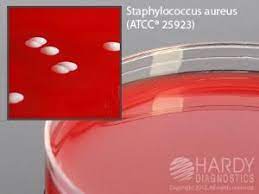Columbia agar with colistin and nalidixic acid (CNA) is a selective and differential medium for isolating and differentiating pathogenic gram-positive cocci from clinical and non-clinical samples. Antimicrobials colistin (C) and nalidixic acid (NA) inhibit gram-negative organisms.
Colistin, a polypeptide antibiotic of the polymyxin group, disrupts the cell membranes of gram-negative organisms. Nalidixic acid, a first-generation quinolone, blocks DNA replication in susceptible gram-negative bacteria.
Columbia agar base is a nutritionally rich formula containing three peptone sources and 5% defibrinated (whole blood with fibrin removed to prevent clotting) sheep blood. This supportive medium is used to differentiate bacterial colonies based on the hemolytic reactions.
Gram-negative bacteria such as members of Enterobacteriaceae and Pseudomonas species are suppressed, while staphylococci, streptococci, enterococci, and yeast grows on Columbia CNA agar.
Table of Contents
Composition
Columbia CNA agar is prepared by adding 10 mg/liter of colistin and 15 mg/liter of nalidixic acid in Columbia Agar Base.
Columbia agar base is a nutritionally rich medium containing 5% defibrinated blood. Sheep blood provides X and V factors for the growth of fastidious gram-positive bacteria and helps differentiate them based on hemolytic reactions.
Peptone supports the luxuriant growth of microorganisms. Cornstarch serves as a neutralizer source. The composition of Columbia CNA agar is as follows*;
| Product | Gram/Liter |
| Casein-Meat Peptone | 10 g |
| Casein-Yeast Peptone | 10 g |
| Heart Peptone | 3 g |
| Sodium chloride | 5 g |
| Corn starch | 1 g |
| Agar | 13.5 g |
| Defibrinated sheep blood | 50 mL |
| Colistin sulfate | 10 mg |
| Nalidixic Acid | 15 mg |
| pH: 7.3 +/- 0.2 |
*Variations in the composition may be seen in media prepared by different manufacturers.
Preparation of Media
- Suspend 44.02 grams in 1000 ml purified/distilled water.
- Heat to boiling to dissolve the medium completely. Do not overheat the medium.
- Sterilize by autoclaving at 15 lbs pressure at 121 for 15 minutes.
- Cool to 45-50°C and aseptically add 5% v/v sterile, defibrinated blood.
- Mix well and pour into sterile Petri plates (20-25 ml per plate in 90 mm Petri plate).
Storage and Shelf Life
Columbia CNA Agar should be protected from light and stored at 4°C to 8°C.
The medium side should be uppermost to prevent excessive moisture accumulation on the agar surface. Under these conditions, the medium has an 8-week shelf life from the date of manufacture.
Quality Control
After checking for correct pH, color, depth, and sterility, the following organisms are used to determine the growth performance of the completed medium.
| Organism | Expected Result |
| Streptococcus pyogenes | Growth, β-hemolysis |
| Streptococcus pneumoniae | Growth, α-hemolysis |
| Staphylococcus aureus | Growth β-hemolysis or no-hemolysis |
| Proteus mirabilis | Partial inhibition |
Inoculation of the Medium
- Allow the medium to reach room temperature before inoculation.
- Using a direct inoculum from the specimen, perform a four-quadrant streak to obtain well-isolated colonies. If desired, stabs into the medium can also be made to improve and better observe hemolytic reactions.
- Depending on the organism of interest, incubate plates aerobically, anaerobically, or in a CO2-enriched environment at 35°C. The hemolytic reaction of some streptococci is influenced by the atmospheric environment of the incubator. For optimal results, culture plates are incubated in a 5% CO2-enriched environment.
- Examine after 24 and 48 hours.
Interpretation of Results
After incubation, examine plates for growth and hemolysis. To observe hemolysis, view the culture plates with a bright light transmitting behind the plate. Four types of hemolysis can be seen in Columbia CNA Agar:
- Alpha-hemolysis: Partial hemolysis results in a greenish discoloration around the colony.
- Beta-hemolysis: Complete lysis of red blood cells resulting in a clear zone around the colonies.
- Gamma-hemolysis: No hemolysis resulting in no change in the medium.
- Alpha-prime-hemolysis: A small zone of complete hydrolysis surrounded by an area of partial hemolysis.
Uses
On conventional blood agar, gram-negative bacilli may outgrow gram-positive cocci. Columbia CNA agar helps to isolate gram-positive cocci (Streptococcus species and Staphylococcus species) when present in a mix-culture with gram-negative bacilli. The addition of sheep blood helps to differentiate species of Streptococcus as well.
References

